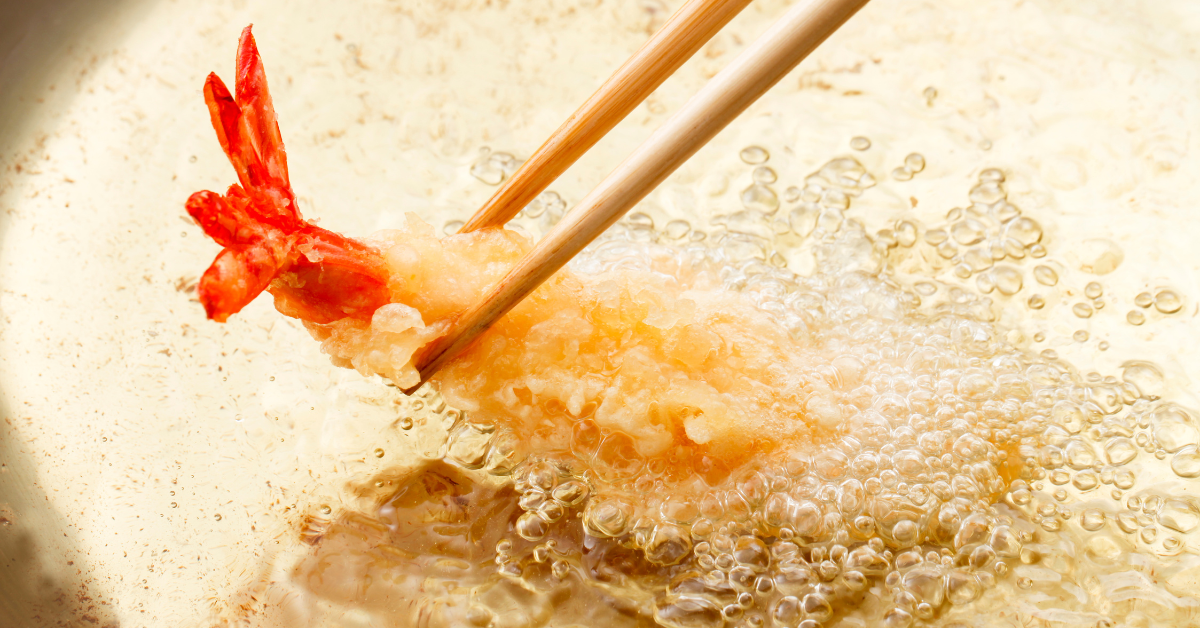Tempura is one of the most beloved dishes in Japan, known for its crispy, light batter that perfectly complements seafood and vegetables. More than just fried food, tempura represents Japanese tradition, seasonality, and refined cooking techniques, making it a must-try experience for anyone exploring Japanese cuisine.
Basic Characteristics of Tempura
Tempura is made by coating ingredients with a wheat flour-based batter and frying them in hot oil. Oils such as sesame oil and rapeseed oil are commonly used, and the aroma and finish change depending on the choice of oil. The ideal result is a dish that has a crispy and light exterior with a soft and fluffy interior. Freshly fried tempura is considered the most delicious, and in specialty restaurants, it is often served piece by piece.
In Japanese cuisine, tempura is not just fried food but a dish that symbolizes delicate techniques. The thickness of the batter, the temperature of the oil, and the frying time are adjusted down to the second, allowing the colors and flavors of the ingredients to be maximized.
History and Origins of Tempura
The origin of tempura dates back to the 16th century, introduced through Portuguese traders. The method of frying ingredients coated in batter was innovative for the Japanese at that time and was soon incorporated into Japanese cuisine. During the Edo period, tempura became popular as a street food in Edo (modern-day Tokyo). It eventually developed into one of Edo’s representative dishes alongside sushi and soba.
Today, “Edo-style tempura,” fried in sesame oil, is regarded as a refined style of cooking and is highly appreciated worldwide.
The Place of Tempura in Japan
In Japan, tempura is enjoyed both as a casual home-cooked dish and as a refined delicacy in high-end restaurants. At home, it is often served on a large plate for the whole family, while in restaurants, each piece is prepared with meticulous care regarding oil, temperature, and timing.
Tempura is also considered a symbol of washoku (traditional Japanese cuisine), alongside sushi, sukiyaki, and soba. It is highly popular among foreign visitors, who view it as one of the must-try Japanese dishes. Another charm is the sense of seasonality; spring brings mountain vegetables, summer features conger eel, autumn offers mushrooms, and winter showcases oysters or cod milt.
Representative Ingredients Used in Tempura
| Ingredient | Characteristics | Season |
|---|---|---|
| Shrimp | The iconic tempura item, known for its plump texture and visual appeal | Year-round |
| White fish (such as sillago or goby) | Light and delicate taste, pairs well with batter | Spring–Summer |
| Vegetables (eggplant, pumpkin, green peppers, etc.) | Colorful, offering sweetness or slight bitterness | Year-round |
| Mushrooms (maitake, shiitake, etc.) | Aromatic with rich texture | Autumn |
| Conger eel | A staple of Edo-style tempura, fluffy texture | Summer |
| Oysters | A winter delicacy, rich and flavorful | Winter |
Ways to Enjoy Tempura
The most common way to enjoy tempura is with “tentsuyu” dipping sauce, made from dashi stock, soy sauce, and mirin, often served with grated daikon radish for a refreshing touch. Another popular method is to eat it with salt, which enhances the natural flavor of the ingredients. Flavored salts such as yuzu salt or matcha salt are also popular.
Furthermore, tempura is widely enjoyed as tendon (tempura rice bowl) or with soba noodles as tenzaru.
Variations in How Tempura is Eaten
| Style | Characteristics | Popular Occasion |
|---|---|---|
| With tentsuyu sauce | Rich umami from dashi, refreshing with grated daikon | Classic way |
| With salt | Simple, highlights ingredient’s natural flavor | Popular in fine dining |
| Tendon (rice bowl) | Generous and filling with rice | Everyday dining |
| Tenzaru soba | Served with cold soba for a refreshing taste | Summer favorite |
Tempura and Regional Culture
Different regions of Japan have developed their own styles of tempura. In Kanto, sesame oil is used for a rich and aromatic flavor, while in Kansai, lighter oils like cottonseed or rapeseed are preferred for a lighter finish. In Kyushu, lotus root and sweet potato are popular ingredients.
These regional differences reflect local tastes and available produce, making tempura a dish that adapts to its environment.
Regional Differences in Tempura
| Region | Type of Oil | Characteristic Ingredients |
|---|---|---|
| Kanto | Sesame oil | Seafood, fried for a bold flavor |
| Kansai | Cottonseed oil, rapeseed oil | Light and crisp finish, more vegetables |
| Kyushu | Rapeseed oil | Sweet potato and lotus root |
The Appeal of Tempura for Foreigners
For foreign visitors, tempura is one of the must-try dishes in Japan. Alongside sushi and ramen, it has high global recognition, and its approachable frying method makes it familiar yet unique.
In addition, the experience of watching a chef prepare each piece of tempura right in front of you leaves a lasting impression. The sizzling sound, the rising aroma, and the visual beauty combine to create an unforgettable Japanese food experience.
Tempura Ingredients Popular with Foreign Visitors
| Ingredient | Reason |
|---|---|
| Shrimp | Elegant appearance and easy to eat |
| Pumpkin | Sweet and appealing, a favorite among vegetable tempura |
| Maitake mushrooms | Fragrant and considered exotic |
| Conger eel | Unique to Japan, adds a sense of luxury |
Conclusion
Tempura has a long history and stands as a true symbol of Japanese food culture. The combination of light batter, seasonal ingredients, and refined cooking techniques has made it a dish loved worldwide.
At home, it is a casual favorite; in specialty restaurants, it is served like a culinary art form. The crispy texture and natural flavors, especially when freshly fried, reflect Japan’s seasons and cultural aesthetics.
When visiting Japan, experiencing authentic tempura is a must, allowing you to taste not just food but the spirit of Japanese tradition itself.






